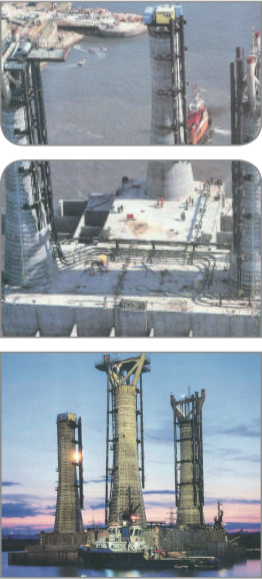
Hamlinton Brothers Oil and Gas Ltd.
Principal Contractor
John Laing ETE Ltd.
Consultant
Ove Arup & Partners
Specialist Contractor
Freyssinet Ltd
Works Completed
1990
The Concrete Gravity Sub-structure (CGS) for Ravenspurn North Gas Field was designed by Ove Arup & Partners. Construction of the £15m concrete jacket was completed by contractor John Laing ETE Limited, in its dry dock facility at Graythorp, on Teesside. The client, Hamilton Brothers Oil & Gas Limited, floated the 27,600 tonne platform out into the Tees Estuary less than 15 months after construction started. The innovative prestressed concrete design was chosen because it was at least 25% cheaper than the conventional steel jacket alternative.
The CGS is in effect a prestressed concrete cellular box, 55 metres x 62 metres in plan, with walls up to 16 metres high. From this cellular box, there are three slip-formed prestressed concrete towers rising 37.5 metres, topped by heavy fabricated steel deck connection legs.
The prestressing in the structure utilized the Freyssinet K-Range system, which consists of a total of almost 400 kilometres of post-tensioning strand. The caisson roof prestressing tendons are the 7K15 type and are horizontal, straight and approximately 50 metres long. In the caisson walls, towing and mooring points, the prestressing tendons comprise of the 12K15 type and are horizontal, straight and 60 metres long. In the tower concrete shafts the tendons are the 15K15 type and are vertical, straight and 55 metres long from the top of the tower to the soffit of the platform. The prestressing strand utilised in the tendons was 15.7 mm diameter super strand conforming to BS 5896 with an ultimate tensile strength of 265 kN, supplied by Somerset Wire Limited.
The post-tensioning throughout the structure had to be carried out in a carefully designed sequence to avoid introducing any differential stresses into the structure during the stressing process. The corrosion protection to the prestressing tendons was provided by a cement grout injected into the ducts under pressure. The cement grout was specially adapted by using an expanding grout admixture and (for the vertical tendons only) an anti-bleed grout admixture. These admixtures were designed to improve the flow and pumping characteristics of the grout. The protection to the anchorages was provided by special caps bolted onto the anchorage head and injected with a special anti-corrosion grease.
Upon completion of the CGS in the dry dock the client floated out the structure into the estuary. The open cells were then flooded and the platform towed into its final position. The whole project was carried out under a strict quality assurance system and Freyssinet conformed to these QA procedures throughout both for materials supplied and the site contract work.
Freyssinet Ltd. Innovation House, Euston Way, Town Centre, Telford, Shropshire, TF3 4LT Phone +44 (0) 1952 201901 Fax +44 (0) 1952 201753 Email info@freyssinet.co.uk
